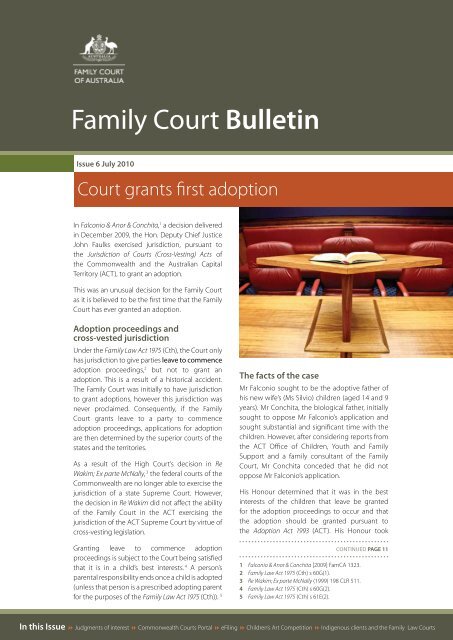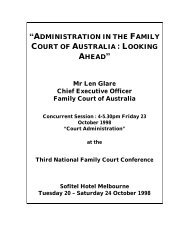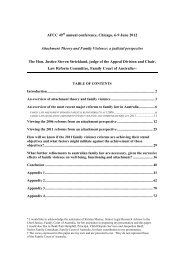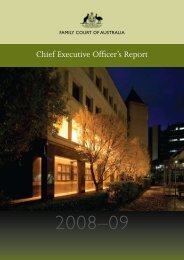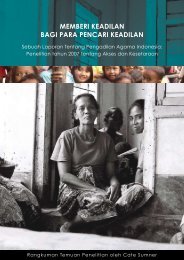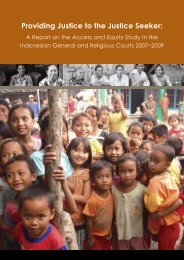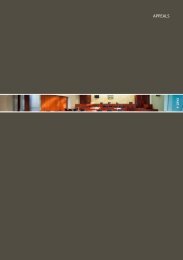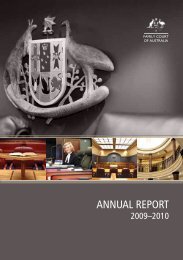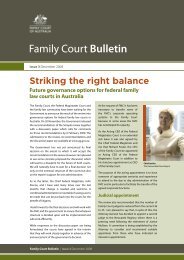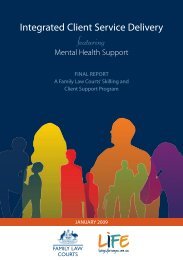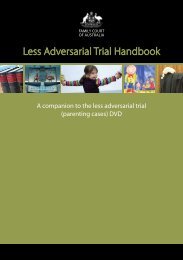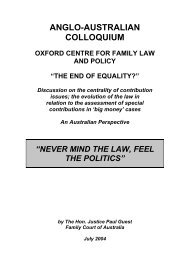Open PDF - Family Court Bulletin - July 2010 - Size 1.4 MB
Open PDF - Family Court Bulletin - July 2010 - Size 1.4 MB
Open PDF - Family Court Bulletin - July 2010 - Size 1.4 MB
- No tags were found...
Create successful ePaper yourself
Turn your PDF publications into a flip-book with our unique Google optimized e-Paper software.
From the Chief JusticeChief Justice Bryant at the InternationalJudicial Conference on Cross Border <strong>Family</strong>Relocation in WashingtonI am pleased to report that in May the Government announcedits plan outlining the future structure of the federal courtsystem. The Attorney-General, the Hon Robert McClelland andMinister for Defence, Senator John Faulkner, announced theGovernment’s decision to establish a new federal court, theMilitary <strong>Court</strong> of Australia, under Chapter III of the AustralianConstitution. This decision impacts on the <strong>Family</strong> <strong>Court</strong> ofAustralia and the Federal Magistrates <strong>Court</strong> of Australia.Under the new arrangements that have been announced, theFederal Magistrates <strong>Court</strong> will be retained and will continueto hear general federal law matters and will be administeredby the Federal <strong>Court</strong>. Some Federal Magistrates will receivedual commissions to enable them to hear particular classes ofmatters in the Military <strong>Court</strong>.A lower tier of the <strong>Family</strong> <strong>Court</strong> will be established andcommissions in the <strong>Family</strong> <strong>Court</strong> in that division will be offered to Federal Magistrates who undertakemainly family law work.We now await the progress of the proposed legislation.In addition to the announcement on the structure of the federal courts, there have been othersignificant changes in the federal judicial system since the last issue of the <strong>Family</strong> <strong>Court</strong> <strong>Bulletin</strong>. Inparticular, Chief Justice Black retired as Chief Justice of the Federal <strong>Court</strong> on 21 March <strong>2010</strong>.On 10 February <strong>2010</strong> the Attorney announced the appointment of the Honourable Justice PatrickKeane, formerly of the Queensland <strong>Court</strong> of Appeal, as Chief Justice of the Federal <strong>Court</strong> of Australia.Chief Justice Keane was sworn in on 22 March <strong>2010</strong>.There are many important issues on which the federal superior courts are required to respond andact, and more often our interests are similar rather than different. I have already met with ChiefJustice Keane to discuss a number of these issues. I look forward to working with him and wish himwell in his new role.The <strong>Family</strong> <strong>Court</strong> has also had three retirements: Justice Warnick from the Appeal Division, BrisbaneRegistry; Justice Flohm from the Parramatta Registry; and Justice Brown from the Melbourne Registry.I hope that in the near future we will have an announcement about new appointments for Sydneyand Parramatta. Justices Jordan and Waddy, who retired in December 2009, are also featured in theRetirements section of this issue.The <strong>Court</strong> has continued to be involved with other courts in legal affairs in our region. Justices Roseand Fowler represented the court recently in China and India respectively. Justice Rose has now givenseveral papers in China on processes in the <strong>Family</strong> <strong>Court</strong>, particularly the Less Adversarial Trial. JusticeFowler joined a delegation of Australian judges who travelled to India late last year to consult withother Indian judges and administrators.There continues to be many overseas conferences at which the input of the <strong>Family</strong> <strong>Court</strong> of Australiais regarded as important. In February I attended the International Judicial Conference on Cross Border<strong>Family</strong> Relocation in Washington which was run by the US State Department and the Hague PrivateInternational Law Secretariat. This was a successful conference. Delegates reached agreement on adocument known as the Washington Declaration on International <strong>Family</strong> Relocation. More than 502<strong>Family</strong> <strong>Court</strong> <strong>Bulletin</strong>8Issue 6 <strong>July</strong> <strong>2010</strong>
International Judicial Conference on Cross Border <strong>Family</strong> Relocation, Washingtonjudges from countries including North America, Europe,South America, India, Pakistan, Australia and NewZealand agreed upon a number of principles about thedetermination of international relocation cases.I also attended the Association of <strong>Family</strong> andConciliation <strong>Court</strong>s conference in Denver, USA inearly June and Deputy Chief Justice will be attendingthe International Child Abduction, Forced Marriageand Relocation Conference in London in early <strong>July</strong>representing the <strong>Family</strong> <strong>Court</strong> of Australia.The Denver conference, which was also attendedby Federal Magistrates Sexton and Altobelli, had asits theme the vexed issue of parental alienation, orperhaps as it is better described, rejecting behaviour.There continues to be a heated debate betweenvarious experts in the United States about whetherthere is a category of alienation which can constitutea psychiatric condition fitting within the DSM 5criteria which experts in Australia have not embraced,and we will watch with interest what happens in theUnited States.Federal Magistrate Altobelli and I presented aworkshop in which we explored whether and towhat extent elements of the Less Adversarial Trialcould be incorporated into a trial court with highvolume workload. Interestingly it emerged that someinternational jurisdictions have incorporated a modifiedversion of the <strong>Family</strong> <strong>Court</strong>’s process into their casemanagement.The Government’s <strong>2010</strong>–11 Federal Budget announcedin May has implications for both the <strong>Family</strong> <strong>Court</strong> andFederal Magistrates <strong>Court</strong>. Essentially, the operationalfunding provided to both <strong>Court</strong>s by the Governmentwill reduce by $6.567m in <strong>2010</strong>–11. This reduction willbe achieved primarily by savings from not replacingsome judicial officers when they retire or resign andfrom the removal of depreciation funding from allGovernment agencies to increase transparency aroundthe budget process as part of ’Operation Sunlight’.The <strong>Court</strong>s are examining ways in which savings canbe achieved without impacting service delivery. It issomething that I will be monitoring closely.The <strong>Court</strong> has responded to the Australian Law ReformCommission’s consultation paper on family violence.In his speech on 17 May at the launch of NationalLaw Week the Attorney-General flagged a number ofinitiatives in which the <strong>Court</strong>s will be involved so asusual, it appears that we will continue to have a busytime ahead in the next few months.<strong>Family</strong> <strong>Court</strong> <strong>Bulletin</strong>8Issue 6 <strong>July</strong> <strong>2010</strong> 3
Judgments of interestMRR v GR [<strong>2010</strong>] HCA 4(French CJ, Gummow, Hayne, Kiefel and Bell JJ), 3 March <strong>2010</strong>The parties lived in the matrimonial home inSydney from 1993 until they separated in 2007when they moved to Mount Isa where the fatherhad secured work. In August 2007 the partiesseparated and the mother returned to Sydneywith the child without the father’s consent.Proceedings were commenced in the FederalMagistrates <strong>Court</strong> which resulted in interim ordersbeing made providing that the mother return to MountIsa with the child and the parties have an equal timeparenting arrangement pursuant to s 65DAA(1) of the<strong>Family</strong> Law Act 1975 (Cth).From the time the mother returned to Mount Isa tothe date of the hearing, the mother had been requiredto live in a caravan park with the child on alternateweeks. The mother said that she could not afford goodquality accommodation in any event and the cheaperrental properties were in ‘rough’ areas. The mother hadlimited opportunities for employment in Mount Isaand supported herself from social security paymentsand income from casual employment. In contrast, themother had full time employment opportunities withher former employer in Sydney.The Federal Magistrate said that he applied thepresumption of equal shared parental responsibility andconsidered that it would not be beneficial to the childif the parents lived ‘thousands of kilometres apart’. Themother appealed to the Full <strong>Court</strong> of the <strong>Family</strong> <strong>Court</strong>of Australia. That appeal was dismissed on the basisthat the Federal Magistrate adequately considered thereasonable practicability of an equal time arrangementand thus no appealable error arose.The mother lodged an application for special leave toappeal against the Full <strong>Court</strong>’s decision to the High<strong>Court</strong> of Australia and special leave was duly granted.In allowing the appeal, the High <strong>Court</strong> found that the<strong>Court</strong> is only empowered to make an order that a childspend equal time with both parents if such an orderis found to be both in the best interests of the childand reasonably practicable. While the Full <strong>Court</strong> of the<strong>Family</strong> <strong>Court</strong> acknowledged that the Federal Magistrate‘did not expressly address the issue of whether an equaltime arrangement would be ‘reasonably practicable’’,the Full <strong>Court</strong> found that the Federal Magistrateconsidered, at some length, the matters under s 60CC indetermining what arrangements are in the child’s bestinterest. The High <strong>Court</strong> disagreed with this approachand found that in applying s 65DAA(1), the <strong>Court</strong> mustbe satisfied that both of the conditions are answered inthe affirmative before making an order for equal time.The High <strong>Court</strong> said:Section 65DAA(1) is expressed in imperative terms.It obliges the <strong>Court</strong> to consider both the questionwhether it is in the best interests of the child to spendequal time with each of the parents (par (a)) and thequestion whether it is reasonably practicable that thechild spend equal time with each of them (par (b)).It is only where both questions are answered in theaffirmative that consideration may be given, underpar (c), to the making of an order.The High <strong>Court</strong> took the matter further proclaimingthat in the absence of an affirmative answer to whetheran equal time arrangement would be reasonablypracticable, there is no power to make an order forequal time parenting.Collu & Rinaldo[<strong>2010</strong>] FamCAFC 53(May, O’Ryan and Strickland JJ),25 March <strong>2010</strong>This international relocation case involved a childwho was aged four years at the date of the appeal.It is the first Full <strong>Court</strong> decision to be handeddown following on from the High <strong>Court</strong>’s decisionin MRR & GR.The parties met in 2002 and commenced a relationshipin 2003. The only child of the relationship was born in2005. The parties resided in Sydney for the majorityof their relationship before the mother relocated withthe child to Dubai in March 2007 with the father’sconsent. The parties’ agreement was that the motherwould live in Dubai for a period of 13 months.4<strong>Family</strong> <strong>Court</strong> <strong>Bulletin</strong>8Issue 6 <strong>July</strong> <strong>2010</strong>
Kostres & Kostres [2009] FamCAFC 222(Bryant CJ, Boland and Jordan JJ), 15 December 2009This appeal is concerned with the interpretationof a financial agreement.Two days before their marriage in January 2002, theparties executed a financial agreement in order toregulate their financial affairs.Without repeating the actual terms of the agreement,it is sufficient to note that the parties’ intention was toisolate their pre-existing assets and that all other assetswhich were obtained during the marriage be sharedmutually between them.Throughout the ensuing years of their marriage, theparties acquired a number of businesses and properties,either in the wife’s name or in her capacity as trustee.The assets were largely funded by way of loans. On theadvice of an accountant a discretionary trust deed wassettled with the wife being appointed sole trustee andprimary beneficiaries consisting of the children fromthe parties’ former marriages.In June 2006, by which time the parties’ marriage hadbroken down, the husband commenced proceedingsin the Federal Magistrates <strong>Court</strong> seeking orders that thewife pay him an amount representing one half of thenet value of assets acquired during the marriage. Thewife agreed with the proposition put forward by thehusband save for her submission that the business wasin her name and therefore should be treated separately.The Federal Magistrate found that the real propertyacquired by the trust was to remain the wife’s property,however the goodwill of the business was a joint assetand should be shared equally between the parties.The husband appealed to the Full <strong>Court</strong> of the <strong>Family</strong><strong>Court</strong> of Australia and the wife cross appealed.The Full <strong>Court</strong> allowed the appeal finding that thefinancial agreement was so ambiguous that it madethe parties’ intention impossible to discern. TheirHonours concluded that ‘care in establishing themutual intention of the parties, and drafting the termsof the financial agreement with precision assume theutmost importance’. It is also relevant to note that theGovernment’s attempt to remedy the strict compliancetest enunciated in Black & Black [2008] FamCAFC 7 didnot apply in this case as it was agreed that no defect inform of the financial agreement was alleged.Before the 13 month period had elapsed, the mothersought an order that she be permitted to remain inDubai for a period of approximately two years. Thisapplication was pursued at trial with an alternativeproposal that the mother and child relocate to NorthQueensland and for the child to spend three monthswith the father in Sydney.Prior to the appeal the arrangement in place for thechild was that he live with each parent on a monthabout basis in Dubai and Sydney. The Full <strong>Court</strong>criticised that arrangement as being unsatisfactory.In light of the recent High <strong>Court</strong> decision in MRR v GR[<strong>2010</strong>] HCA 4, their Honours provided the parties withan opportunity to make further submissionsThe mother’s complaints were summarised into threebroad areas:1. the mother’s attitude to the relationship of thechild and father and her capacity to provide for theemotional needs of the child2. the trial Judge failing to adequately assess andweigh up all of the relevant considerationsregarding the best interests of the child, and3. the trial Judge failing to adequately deal with thestatutory considerations for considering whetherthe child should spend equal or substantial andsignificant time with each parent.On the first issue the Full <strong>Court</strong> found that the trialJudge erred in relation to the various matters thatshe took into account in forming her view aboutthe mother and further did not consider, weigh andassess the evidence regarding the best interests ofthe child. On the issue of equal time, the Full <strong>Court</strong>found that the trial Judge was obliged to undertakewhat the High <strong>Court</strong> in MRR v GR (supra) describedas a ‘practical assessment’ of whether equal time orsubstantial and significant time was ‘feasible’. Theappeal was subsequently allowed and remitted to forredetermination.<strong>Family</strong> <strong>Court</strong> <strong>Bulletin</strong>8Issue 6 <strong>July</strong> <strong>2010</strong> 5
Initiatives and Programs [continued]My Beautiful WorldChildren’s Art CompetitionThe <strong>Family</strong> Law <strong>Court</strong>s’ Children’s Art Competition ran from May to June this year, with the winners announced duringthe last week of June. The competition was a great success, with over 150 entries received from all over Australia.There were 10 winners who each received a personally engraved MP3 player, with 13 entrants receiving a HighlyCommended certificate. Some of the winning artwork is pictured below.Charlie age 6Isabella age 10Alexa age 11Ysabelle age 11Charlotte age 7Soraya age 118<strong>Family</strong> <strong>Court</strong> <strong>Bulletin</strong>8Issue 6 <strong>July</strong> <strong>2010</strong>
NEW publicationsService CharterThe Service Charters for the <strong>Family</strong> <strong>Court</strong> and theFederal Magistrates <strong>Court</strong> have been amalgamatedinto one document. This document is available on the<strong>Court</strong>s’ websites at:8 www.familycourt.gov.au8 www.fmc.gov.auService CommitmentsThe Service Commitments document is a summary ofthe Service Charter and has been developed for displayat registries and for distribution to clients.For more information about either document, pleasecontact <strong>Family</strong> Law <strong>Court</strong>s National Communication on:8 Phone: (02) 6243 86908 Email: communication@familylawcourts.gov.auService Charterfor the <strong>Family</strong> <strong>Court</strong> of Australiaand the Federal Magistrates <strong>Court</strong> of AustraliaOur service commitmentsThis document outlines the service you can expect from the administrative staffof the <strong>Family</strong> <strong>Court</strong> of Australia and the Federal Magistrates <strong>Court</strong> of Australia.It does not relate to the work that is performed by judges or federal magistrates.More information can be found in the <strong>Court</strong>s’ Service Charter, available under the publicationssection of the website: www.familylawcourts.gov.auThe <strong>Family</strong> <strong>Court</strong> of Australia and the Federal Magistrates <strong>Court</strong> of Australia are independent courtsbut cooperate to provide streamlined access to the federal family law system. The Federal Magistrates<strong>Court</strong> also deal with general federal law matters.What you can expect from our staffOur staff will:■ Be courteous, helpful and respectful to your individual needs.■ Respect your rights whether you have legal representation or not and treat all parties fairly.■ Give you prompt and responsive service.■ Respect your privacy (unless there are legal requirements to disclose information).■ Deliver services for parties and lawyers in a safe and secure environment.■ Provide information about the interests of the children in parenting matters, conciliation inproperty and financial disputes and where appropriate, refer you to community-based supportservices.■ Provide accurate up-to-date information that is clear and understandable.■ Assist, where possible, to overcome any personal barriers to a person’s dealings with thecourts – such as distance, physical, hearing or visual difficulties, or non-English speakingbackground.www.familycourt.gov.auIn 2009–10 the <strong>Family</strong> <strong>Court</strong>of Australia website was visited892 360 times. Of these, 462 233 werevisiting the website for the first time.www.familylawcourts.gov.auIn 2009–10 the <strong>Family</strong> Law <strong>Court</strong>s websitewas visited 766 120 times. Of these, 518 714 werevisiting the website for the first time.This is an increase from 2008-09 of177 460 visitors and 120 630 first time visitors.The top three most frequently viewed <strong>Family</strong> Law<strong>Court</strong>s web pages in May <strong>2010</strong> were:8 Forms 8 Separation and Divorce8 Divorce forms and kitsThe three most common search keywords on the<strong>Family</strong> Law <strong>Court</strong>s website were:This represents an increase from 2008-09 of153 674 visitors and 84 068 first time visitors.The top three most frequently viewed <strong>Family</strong><strong>Court</strong> web pages in May <strong>2010</strong> were:8 Forms and Fees 8 <strong>Court</strong> lists8 JudgmentsThe three most commonsearch keywords onthe <strong>Family</strong> Law <strong>Court</strong>swebsite were:courtAustraliafamilydivorceAustraliafamily<strong>Family</strong> <strong>Court</strong> <strong>Bulletin</strong>8Issue 6 <strong>July</strong> <strong>2010</strong> 9
International Association of Women Judges’Conference, Seoul, South KoreaDuring the week of 10 May <strong>2010</strong> over 400 womenjudges met in Seoul at the 10th InternationalAssociation of Women Judges Conference.Among the delegates were judges from Afghanistan,Haiti and Nepal. The Australian women judgesarranged for sponsorship of two judges from PapuaNew Guinea and one judge from Timor Leste.As a member of the association, Justice Bolandwas pleased to be able to attend the conference.All branches of the Australian judiciary were wellrepresented led by her Honour Judge Sarah Bradley,the President of the Australian Association and theHonourable Justice Margaret Beazley of the NewSouth Wales <strong>Court</strong> of Appeal who is a member ofthe executive board of the International Association.The Australian judges were honoured to be invitedby the Australian Ambassador to South and NorthKorea, Mr Sam Gerovich, to lunch with him during theconference.The International Association of Women Judges(IAWJ) is a non-profit, non-partisan organisation ofmore than 4000 members at all levels of the judiciaryin more than 90 nations. Since being formed in 1991,the IAWJ has attracted membership by womenjudges from diverse legal-judicial systems who sharea commitment to equal justice under the rule of law.The Australian branch of the association was formedin 1992 at the instigation of Justice Jane Matthewsand the former Chief Justice of the <strong>Family</strong> <strong>Court</strong>, theHonourable Elizabeth Evatt. Justice Boland was on theorganising committee when the 8th IAWJ conferencewas held in Sydney four years ago. Chief Justice Bryanthas recently agreed to be the representative of theFederal <strong>Court</strong>s for the Australian association.‘It is a very humbling experience to hear of thework being carried out by members of the IAWJ inextraordinarily difficult conditions. The Haitian judgestold us of the destruction of their <strong>Court</strong>, the death oftwo of their Judges, and their struggle to maintainAustralian and South Korean judges with two Judges from the Netherlands. The Australian judges are her Honour Justice Debra Mullins,Queensland Supreme <strong>Court</strong>, her Honour Judge Robyn Tupman, NSW District <strong>Court</strong>, her Honour Justice Jennifer Boland, and Magistrate WendyCull (Queensland).10<strong>Family</strong> <strong>Court</strong> <strong>Bulletin</strong>8Issue 6 <strong>July</strong> <strong>2010</strong>
the rule of law following the devastating earthquake.It was inspiring to learn of the achievements onejudge in California had brought about with almostno resources when she was placed in charge ofguardianship matters. Her work has led to theestablishment of an Elder Law Centre, social supportfor the disabled including those suffering withdementia and an effective and compassionate courtprocess’ Justice Boland said.Significant papers dealing with matters as diverseas reproductive technology law in Italy, judicialparticipation on the International Criminal <strong>Court</strong> and atransforming decision of the Delhi High <strong>Court</strong> dealingwith the rights of gay and homosexual persons werecovered in the conference.The next conference will be held in London in 2012under the auspices of the new president of theassociation Lady Brenda Hale of the U.K. Supreme<strong>Court</strong>.continued from page 1<strong>Court</strong> grants first adoptioninto account Mr Conchita’s attitude towards thechildren and acknowledgment that he would begiving up parental responsibility; the geographicalimpediments to Mr Conchita spending time withthe children, and the minimal amount of timeMr Conchita had actually spent with the children.His Honour also took into account the nature of therelationship between the children and Mr Falconioand Ms Silvio and the environment they couldoffer the children. His Honour also ordered that thechildren spend such time with Mr Conchita as theywished, and for their surnames to be changed toreflect both Mr Falconio and Ms Silvio’s surnames.<strong>Court</strong> fees up from 1 <strong>July</strong> <strong>2010</strong>The <strong>Court</strong>s have received notification of the biennialincrease of the prescribed <strong>Family</strong> <strong>Court</strong> and FederalMagistrate <strong>Court</strong> fees from the Attorney-General’sDepartment.U.K. Judges and Boland J at the conference dinnerThe new fee schedule applies from 1 <strong>July</strong> <strong>2010</strong>.Information about the new fees is available onwww.familylawcourts.gov.auValeGeorge Ernest LambertThe Honourable George Ernest Lambert,retired Justice of the <strong>Family</strong> <strong>Court</strong> ofAustralia, passed away peacefully on26 March <strong>2010</strong>. The <strong>Court</strong> offers itscondolences to George’s family and friends.Executive AppointmentMr Richard FosterRichard Foster has beenre‐appointed as the <strong>Family</strong><strong>Court</strong>’s Chief ExecutiveOfficer. Richard’s contracthas been extended for afurther five years.<strong>Family</strong> <strong>Court</strong> <strong>Bulletin</strong>8Issue 6 <strong>July</strong> <strong>2010</strong> 11
RetirementsJustice WarnickJustice Warnick resigned his commission as a judge of the <strong>Family</strong> <strong>Court</strong> on 31 March<strong>2010</strong>. Justice Warnick was appointed to the <strong>Family</strong> <strong>Court</strong> on 2 September 1991, having beena member of the bar prior to his appointment. On 12 December 2002, he was appointedto the Appeal Division. His Honour’s contribution to the jurisprudence of the court wassignificant particularly during the post-2006 amendments.Justice BrownJustice Brown resigned her commission as a judge of the <strong>Family</strong> <strong>Court</strong> on 2 June <strong>2010</strong>.Justice Brown was a judge of the <strong>Family</strong> <strong>Court</strong> for over 16 years. For many years undertookresponsibility for the administrative functions for the Southern Region of the <strong>Court</strong> andthrough the Chief Justice’s Consultative Committee for the wider administration of the <strong>Court</strong>.Justice Brown is widely respected both inside and outside the <strong>Court</strong> for her prodigious workethic, her sound judgment and support of the <strong>Court</strong>, particularly the Melbourne Registry.Justice Waddy RfdJustice Waddy resigned his commission as a judge of the <strong>Family</strong> <strong>Court</strong> on 17 December2009. Justice Waddy was educated at the King’s School in Parramatta on a scholarship. Hecompleted a Bachelor of Laws at the University of Sydney in 1962 and became an associate tohis Honour Nagle J of the New South Wales Supreme <strong>Court</strong> in 1963. Following admission to theNew South Wales Bar in the same year, Justice Waddy practised as a barrister-at-law, becomingQueen’s Counsel in 1988. After a long and successful career at the bar, he was appointed tothe bench of the <strong>Family</strong> <strong>Court</strong> in <strong>July</strong> 1998. His colleagues will remember his unfailing judicialcourtroom conduct, his dignity and unwavering courtesy in the courtroom.Justice JordanJustice Jordan retired on 31 December 2009 after 15 years as a judge of the <strong>Family</strong><strong>Court</strong>. Justice Jordan completed a Bachelor of Law at the University of Queensland andenjoyed 21 years working in law before he was sworn in as a judge of the <strong>Court</strong> in 1994.Justice FlohmJustice Flohm retired on 29 April <strong>2010</strong>, after almost 11 years as a judge of the <strong>Family</strong> <strong>Court</strong> at Parramatta.During this period her honour served for five years as the first Magellan judge of NSW, as well as six years as theParramatta case management judge. On leaving school Justice Flohm continued with classical ballet studies beforeheading to Europe where she worked in the fashion industry for several years, as an executive director of a lifestylemagazine and as an assistant TV film producer. Her honour completed a Bachelor of Arts in 1978 and Bachelor of Lawsin 1981 and was admitted to practice as a Barrister of the Supreme <strong>Court</strong> of NSW in 1982, enjoying 17 years working inlaw before being sworn in as a judge of the <strong>Court</strong> in 1999.Further InformationFor more information about this publication—including ordering additional copies or to make changes to your mailing details (includingremoval from the mailing list)—contact the <strong>Family</strong> Law <strong>Court</strong>s National Communication Office.T (02) 6243 8690 8 F (02) 6243 8711E communication@familylawcourts.gov.au<strong>Family</strong> <strong>Court</strong> <strong>Bulletin</strong>8Issue 6 <strong>July</strong> <strong>2010</strong>


